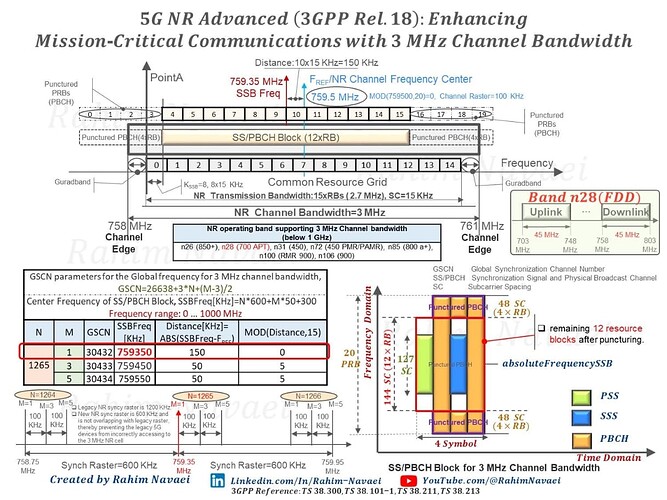-
Mission-critical networks encompass a range of use cases vital for government and key industry verticals, such as public safety, utilities, defense, and rail transport. These verticals share similar implementation features and design needs such as requiring mission-critical communications to meet stringent performance requirements, including high reliability, availability, resilience and security, while operating with narrow bandwidth.
-
The 3GPP Release 18 has included advancements in spectrum utilization for 5G NR, crucial for networks requiring mission critical communications. To achieve this, 3GPP has introduced operation in a narrowband spectrum with channels smaller than 5 MHz. Specifically, 3GPP has specified a new channel bandwidth of 3 MHz (15 RBs) ,a new synchronization raster (600 KHz) and the technique of SSB (Synchronization Signal Block) puncturing.
-
The existing, or legacy NR synchronization raster which is 1200 KHz was designed for the minimum channel BW of 5 MHz. For new 3 MHz channel bandwidth, 3GPP has specified a new dedicated synchronization raster (600 KHz). The new NR synchronization raster is distinct and does not overlap with the legacy synchronization raster, thereby preventing the legacy 5G devices from incorrectly accessing to the 3 MHz NR cell.
-
3GPP has specified the following frequency bands , which are below 1 GHz, to support the new 3 MHz channel bandwidth:
- n26 (850+), n28 (700 APT), n31 (450), n72 (450 PMR/PAMR), n85 (800 a+), n100 (RMR 900), n106 (900)
- In the case of band n100, there are two special synchronization raster points dedicated to 12 RBs and 20 RBs available transmission BWs in 3 and 5 MHz channel bandwidths, respectively.
-
Here I try to depict how a punctured SS/PBCH block can be mapped onto the new 3 MHz channel of 5G NR in band n28 (700 MHz, APT).
LinkedIn: ![]()
